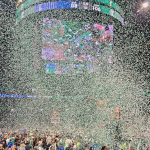
Do football clubs need a creative director?
The new professional figure who can definitively transform a team into a brand
August 2nd, 2021
The image of a brand is one of the most important things, as if it were an instant business card that immediately communicates something. This applies to every sector: whether it's fashion or football, the visual aspect is central especially in the era in which brand identity is predominant. Football teams - which are slowly evolving into brands - are lagging behind on these dynamics. Just think that communication and image care are often delegated to external agencies, outsourcing a unit that goes against the concept of "every company is a media company". In fashion, on the other hand, the image is at the center of every strategy and the connecting figures who coordinate and take care of it are the creative directors, a role that has evolved over the years and has changed a lot according to the new needs of the brands.
The approach to the role of creative director in the fashion sector today has completely changed: from the technical stylists who worked on the pattern and the sewing machine, today the creative director tries to offer a vision of the immaterial world, interpreting the present rather than physically creating it. Proof of this change can be seen from the backgrounds of the greatest creative directors of the moment: Virgil Abloh studied architecture, Raf Simons started designing furniture, Matthew Williams came into contact with the fashion industry as a product manager after being discarded by Parsons. School of Design and Kanye West has a primarily musical background. All this translates into the idea that contamination and cross-sectoriality are the most effective lenses for dealing with contemporary culture and at the same time offering the consumer a product that has a symbolic rather than material value. Even if the dynamics of football do not follow the rhythms of fashion, it's precisely at the moment when the fashion industry has opened up that it has regained its centrality in public discourse. In the same way, football today remains one of the most followed sectors and sports but remains an industry that is not very reactive to aesthetic innovation, where - paradoxically - there is a creative underground that has been in turmoil for years and a mainstream (big clubs) that they struggle to find a visual and communicative identity in step with the times.
The figure of a creative director within the organization chart of a football club seems to be essential to unite and communicate two sectors that are getting closer and closer. Their function is not limited to the creation of lifestyle collection concepts, but is much broader. A sports creative director must be able to synthesize and tell the values of a brand (as in the case of Inter's "Buu - Brothers Universally United" campaign), inspire moodboards that give materiality to what you want to communicate (as in the case of a channel dedicated only to the streetwear attitude of a club).
Despite the excellent examples of collaboration between football clubs and brands - adidas x Juve or Jordan x PSG - or supplier - Thom Browne x Barça - the latest experiments have shown the need for a figure like a creative director. To avoid contaminations having mixed results (such as the latest striking cases of the self-produced collections of Juventus and Barcelona) and above all to avoid the possibility of creating something without identity with ideas that seem extrapolated from other contexts, the new sports brands are called to a real cultural revolution. A revolution that can come only and exclusively through a "long process, linked to the city and the community" as explained by Daniel Arsham, creative director of the Cleveland Cavaliers, in an exclusive interview with nss magazine. It's not only necessary to focus on the final goal as a release can be, but the creative director must be able to create those extra sectorial links that allow the club to give a different external image.
The world of sport, to date, offers negative and positive cases. If we stay beyond football, the Ferrari of the new creative director Rocco Iannone - formerly Pal Zileri and with experience in the ateliers of Dolce & Gabbana and Armani - launched the first fashion collection with the Prancing Horse brand without convincing critics too much, despite the Maranello show. Ferrari's not exceptional debut in the fashion sector leads us to think that having a creative director is not enough to resolve the dialogue between sport and fashion and that the production of a collection is not enough to be included in the group of teams that use fashion to complete the own offer. To be able to give value to the heritage of a brand like Ferrari - made up of fonts, colors and palettes - it is necessary to be able to tell, update and condense the main elements in a show, without pretending to be inspired by shapes. of design to draw clothes.
On the one hand Arsham with the Cavs already accustomed to an American world and system that is the natural habitat for this type of merger, on the other a bet that has not paid the right dividends despite Ferrari's good intentions. Arsham's first task - which has a certain background that harmoniously blends design and fashion - was not to create a collection or a collaboration that would change the perception of the Ohio franchise, but to reorganize the very image of the company starting from the points strength of the city (especially rock & roll) and enhancing the messages that the Cavs want to convey through basketball. Since there is no certainty about the outcome of the investment, the question of whether or not it is necessary to include a professional figure such as a creative director remains legitimate. The needs of the football industry have changed and the figures who work within it should also change. The world of football is by definition conservative and therefore reluctant to cultural processes that upset what is considered the normal flow of events, but the thrust and example that comes from the fashion world is clearer than ever.



















